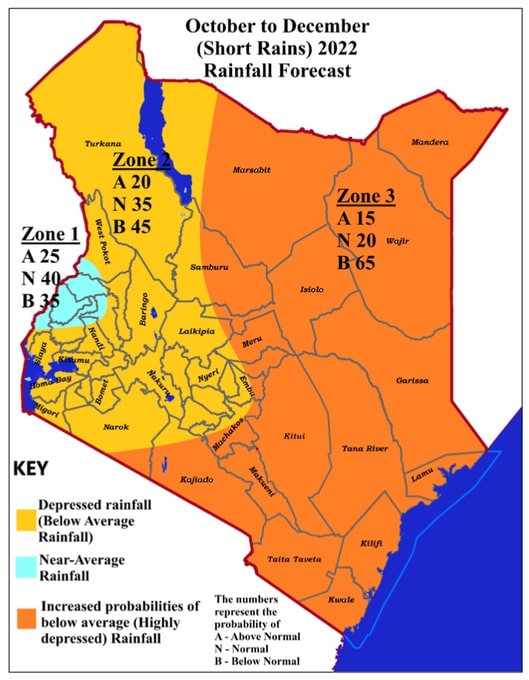- Hits: 2311
Farmers advised to grow drought-resistant crops as weatherman warns of failed short rains

By George Munene
The Kenya Meteorological Department has advised farmers to plant early maturing and drought-resistant varieties of crops, fodder, and pasture as it warns of a fifth consecutive unsuccessful rainy season over the October-November-December (OND) 2022 short rains season.
According to its just-released report ‘The Climate Outlook for the October-November-December (OND) 2022 “Short Rains” season’ it is expected that most parts of the country will experience below-average rainfall that will be poorly distributed.
The expected late rain onsets, poor distribution, and reduced amounts of rainfall is likely to negatively affect agricultural production, leading to poor yields of crops, livestock, and fisheries.
This will be especially impactful in Arid and Semiarid Lands (ASALs) areas in the Northern and Eastern parts and particularly in the Eastern sector where reliance on short rains is high.
Thus, food prices are expected to rise and accessibility to staple food is also expected to be poor. This will in turn lead to an increase in food deficits in these areas.
The depressed rainfall expected in the ASAL areas will impact negatively the availability of foliage and pasture in the pastoral areas of Northeastern, Northwestern, Coastal, and Southeastern Kenya.
The parastatal advises that the ongoing livestock offtake programs in these areas should be enhanced to prevent further loss of livelihoods.
There is a likelihood of an increase in crop pests such as fall army warms and animal diseases as livestock migrate in search of water and pasture. Therefore, integrated pest and disease surveillance, control, and prevention should be enhanced.
Related News: Farmers grapple with failed crop as rains fail
Related News: Farmers build forage reserves ahead of forecast January drought
The specific outlook for October-November-December (OND) 2022 is as follows:
The Lake Victoria Basin, Highlands West of the Rift Valley, and Central and South Rift Valley: (Siaya, Kisumu, Homa Bay, Migori, Kisii, Nyamira, Baringo, Uasin Gishu, West Pokot, Elgeyo Marakwet, Nandi, Kericho, Vihiga, Laikipia, Nakuru and Narok)
In these counties, depressed rainfall, i.e, below the long-term average amounts expected for the season.
Occasional showers and thunderstorms are expected to continue throughout the season.
The rains are expected to begin in September and last through the fourth week of December, and to the first week of January 2023 in the Southern Rift Valley (Narok).
However, a few counties (Bungoma, Kakamega, Busia, Trans Nzoia, and the extreme southern parts of West Pokot) are likely to experience near-average rains with a tendency to below-average rainfall.
The peak of the season is expected in November.
The expected rainfall is likely to be poorly distributed in both time and space.
Highlands East of the Rift Valley Counties (including Nairobi area): (Nyandarua, Nyeri, Kirinyaga, Murang'a, Kiambu, Meru, Embu, Tharaka Nithi and Nairobi)
These counties are likely to experience occasional rainfall during the season.
Rainfall amounts are expected to be lower than the season's long-term average.
Here, the rains should begin on the fourth week of October through the first week of
November and last till the third to fourth week of December.
Northwestern Counties: (Turkana, and Samburu)
They are likely to experience depressed rainfall below the long-term average for the season
Long dry spells are also likely during the season with mainly sunny and dry weather conditions for most of the season.
However, showers and thunderstorms are likely to occur on a few days during the season.
South-eastern Lowlands Counties: (Kitui, Makueni, Machakos, Taita Taveta, and Kajiado)
These counties are expected to experience occasional rainfall during the season.
The expected rainfall amount is likely to be below the long-term average for the season.
They should begin in the first to the second week of November through to the third to fourth week of December.
Related News: Water reservoirs enable farmers earn a premium and halve production costs
Related News: Stored fodder gives farmer milk during drought
North-Eastern Counties: (Mandera, Marsabit, Wajir, Garissa, and Isiolo)
These areas are expected to experience mainly sunny and dry weather conditions and only a few days of rainfall.
The expected rainfall amount is likely to be below the long-term average for the season, and it is likely to be poorly distributed in both time and space.
The Coastal Counties: (Mombasa, Tana River, Kilifi, Lamu, and Kwale)
These counties are expected to receive occasional rainfall during the season.
The expected rainfall is likely to be below the long-term average amounts for the season. It is likely to be poorly distributed in both time and space.
It should begin raining in the third to fourth week of November, through to the third to fourth week of December.
Write comment (0 Comments)
















